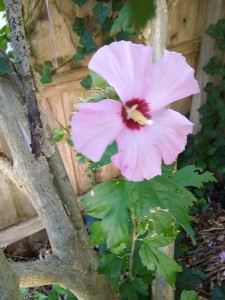 It is late summertime, when thoughts turn to back-to-school, shorter days, and, for some people, the imminent return of pumpkin spice-everything. For me, it is mallow time.
It is late summertime, when thoughts turn to back-to-school, shorter days, and, for some people, the imminent return of pumpkin spice-everything. For me, it is mallow time.
The mallow or Malvaceae family is large, containing nearly 250 genera, over 4,000 individual species and even more cultivated varieties. If the words “malva” and “Malvaceae” mean nothing to you, think about common garden hollyhocks or shrubby roses of Sharon, both blooming now in rural, suburban and urban areas. The enormous, eight to ten inch-wide blooms of hardy hibiscus varieties like ‘Disco Belle’ and ‘Kopper King’ just about smack you in the face when you encounter them in garden centers. All three are members of the mallow family, as is tropical hibiscus. In my part of the world, sunny porches, patios and pool enclosures are required by law—or so it seems—to harbor potted tropical hibiscus, which come in a wider array of colors every year. I am positive about this because I have two on my back porch right now.
Mallows have many common traits, but the most obvious is hollyhock-like flowers, which generally have five colorful petals arranged around a prominent central column of fused stamens. The flowers can be single, often with wavy edges or fully double, with a fistful of fluffy petals. If you spot a flower that looks like a hollyhock, it is almost certainly adorning a member of the mallow family.
My first malva was the hollyhock that grew in the backyard of my childhood home. The original probably came about due to bird or animal landscaping, but I helped nature along by planting the little bulls-eye seeds when the seedpods split open.
My hollyhocks belonged to Alcea rosea, one of about 50 Alcea species. They are distinguished by their tall, somewhat hirsute stalks and big, lobed leaves. I don’t have any in the garden now, but I do have six or seven roses of Sharon, known to botanists as Hibiscus syriacus, one of about 300 hibiscus species. Another is Hibiscus rosa-sinensis, which includes those flashy tropical hibiscus on the back porch. My upper back garden is home to the bodacious “Disco Belle Pink”, not to mention an anonymous red-flowered specimen that belongs to the hardy hibiscus species, Hibiscus x moscheutos.
Clearly, I am awash in mallows.
Mallow flowers remind me a little of poppies—colorful and ephemeral. Each rose of Sharon bloom lasts only a single day, with hollyhocks and tropical hibiscus flowers staying on the stalk a bit longer. The beautiful, short-lived flower petals are not terribly substantial. Despite that, the plants themselves have staying power.
Roses of Sharon may have a defined lifespan, but they self-seed so readily that they might as well be immortal. A mature rose of Sharon also produces hundreds of blooms in a flowering season that lasts up to a month or more. Tall hollyhocks, opening from the bottom up, crank out flowers for two weeks. The hardy hibiscus sprout flowers of eye-popping size for at least 10 days or more. Swamp and bog areas, like the New Jersey Meadowlands, are home to the prolific seashore mallow, which goes by the tongue-mangling Latin name of Kosteletzkya virginica. The pink-flowered mallows bloom from June through September, beautifying places that are often considered waste spaces.
If you like mallows, but have to devote all your available space to edible plants, you can still get in on the mallow act by growing okra, also known as Abelmoschus esculentus. Prior to producing its fruits, okra plants dazzle with white or yellow hollyhock-like flowers, each bearing a dramatic dark central “eye”. The same kinds of flowers are also characteristic of another useful species, Gossypium hirsutum, otherwise known as cotton.
If you are not already swimming in mallows and need more representatives of the genus in your life, there are many to pick from. The high mallows or Malva sylvestris have been popular over the few decades, especially a variety called ‘Zebrina’. High mallows are much like hollyhocks except a little more elegant in appearance and a bit more compact. ‘Zebrina’ grows two to four feet tall, with lavender flowers striped in darkest red. The plants are sun-loving, short-lived perennials that will work in large containers. In the garden, ‘Zebrina’ looks best when planted in odd-numbered groups.
Prairie mallow or Sidalcea is sometimes known as “miniature hollyhock.” Like some other mallows, the plants tend to form clumps when they are well situated. The leaves are slightly to deeply lobed, depending on proximity to the ground, but almost no one buys any mallow solely for its foliage. Sidalcea also grows two to four feet tall, with erect spikes of pink flowers that appear in summer. Though the flowers have the typical hollyhock configuration, they are more delicate in appearance. “Elsie Heugh’, winner of the Royal Horticultural Society’s Award of Garden Merit (AGM), is my favorite sidalcea because of its elegant fringed petals.
No good flower garden should be without some kind of mallow. The problem—at least in my garden—is finding room for one more.
